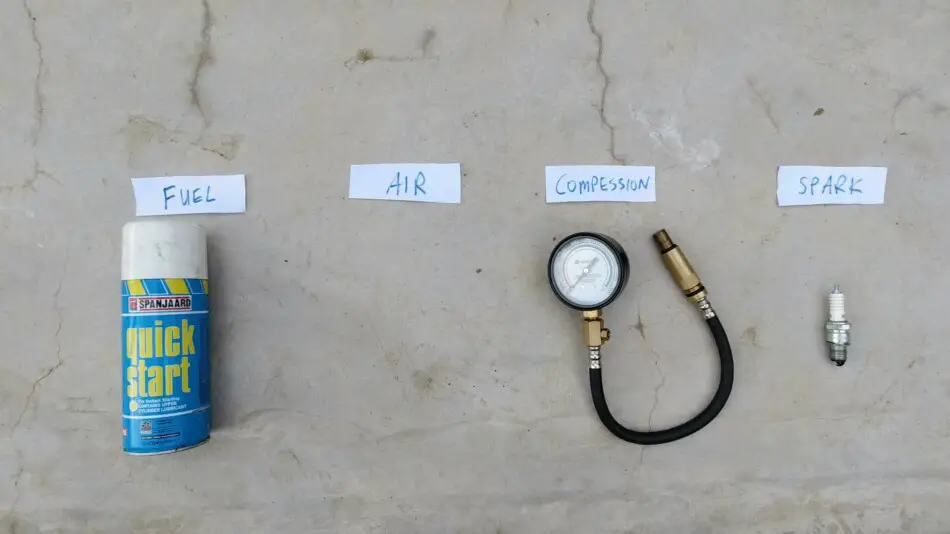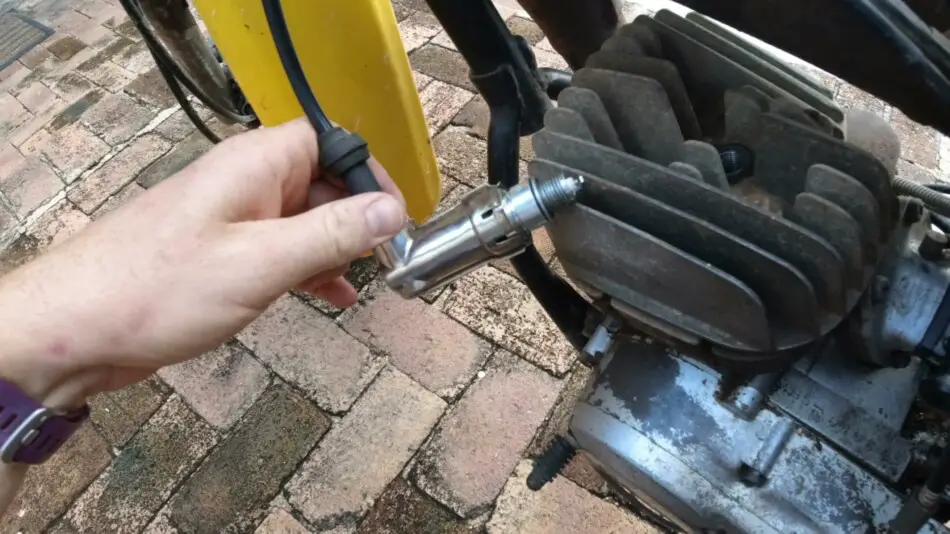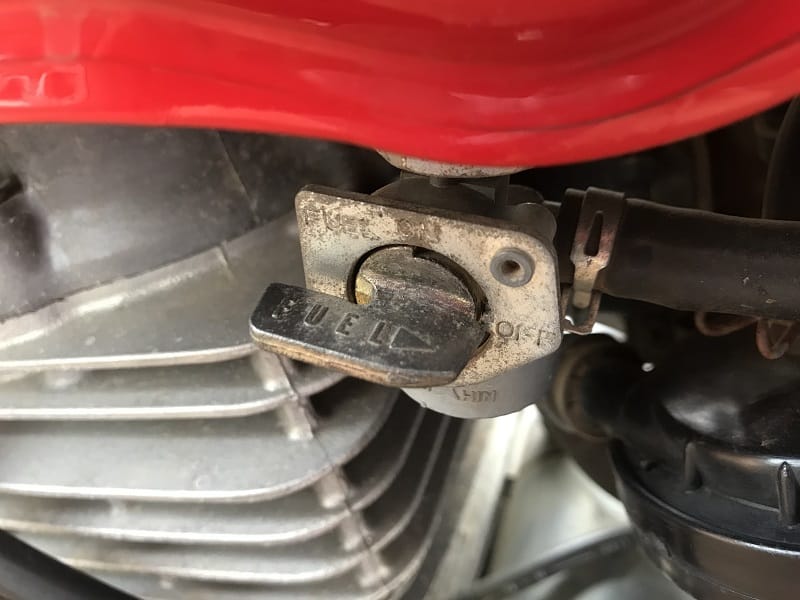A motorcycle that starts fine when cold, but struggles to start when the engine is hot can be very frustrating, especially if the bike stalls in traffic. Unfortunately, there are many different reasons why your motorcycle won’t hot start which could make it difficult to diagnose.
A motorcycle that does not start when it is hot could be caused by a weak battery, failing coil or starter, or dirty temperature sensors. Vapor lock, a flooded carburetor or vacuum leak, or too tight valve clearances could also cause a bike not to start when the engine is hot.
If your bike is having trouble starting after you’ve ridden a few miles, don’t despair. Make yourself a cup of tea, take a deep breath, and take a methodical approach to find the problem. Then fix it yourself.
We’ll first take a broad look at the three main systems that could cause your bike not to start when the engine is hot. Then we’ll discuss a few things which you could check in more detail under each one.
Motorcycle Won’t Start When it is Hot: Three Main Causes
So your motorcycle started fine this morning when the engine was cold, but after filling up at the gas station, the hot engine won’t start. You’ve waited a few minutes for the engine to cool down, and voila! It starts right up again. What is going on?
Your motorcycle requires four things to start and run: Air, fuel, spark, and compression. If it is not getting any air (e.g. a dirty air filter element), the bike would not have started when cooled down either. This leaves three main systems to diagnose: Fuel, spark, and compression.

Most riders jump to the conclusion that a hart starting problem is caused by a fuel delivery problem. Electrical gremlins, however, often fool us by showing similar symptoms. You need to work methodically and eliminate one potential problem at a time.
Don’t do what I usually do and haphazardly try a bunch of things all at once.
Let’s have a look at each system and discuss a few possible reasons for your motorcycle not to start when the engine is hot. I’ll start with the most intimidating, yet most likely area, the electrics (or spark).
Difficult Hot Starting: Electrical Problems
The reason I’d look at the electrics (or ignition) first is because you can quickly diagnose it by testing whether your motorcycle has a strong spark. If you cannot access the spark plug easily, you may want to first eliminate fueling issues in the next section.
How to test for spark
To confirm whether your motorcycle is not starting as a result of an electrical problem, you can check whether the spark plug is firing or not. Pull the spark plug wire and remove the spark plug. It is best to replace it with a new plug (to be sure). Fit the new spark plug into the spark plug boot and ground out the thread of the spark plug to the engine case (or any good grounded component).
Hold onto the spark plug boot, not the metal part of the plug, to prevent electrical shock. Now crank the engine. You should be able to see a strong, blue spark across the spark plug tip. You may have to shield the tip from direct sunlight in order to see the spark.

If there is no spark or the spark is a weak orange or yellow color, then you’re one step closer to finding the cause for your motorcycle not to start when it is hot.
NOTE: For a complete post on why your motorcycle does not have spark, check out this post.
Let’s look at possible causes for the weak (or non-existent) spark.
Weak battery
This might seem backwards, but in some cases a weak battery will be able to start a cold engine, but not a hot one. The reason is that the compression in the engine is higher when the engine is hot due to expansion of hot internal components.
A discharged or weak battery may have enough juice to crank over the starter and start a cold engine, but just not enough to fire up a hot engine with higher compression. This may be evidenced by the starter spinning over slower when the engine is hot, than when cold.
Check the battery with a voltmeter. Anything below 12.4V indicates that your battery may be the problem. A weak battery can cause a whole range of symptoms that may seem like something more serious is wrong. Cold starting could also become a problem if your bike’s battery is getting old.
Fix: Charge your motorcycle’s battery overnight and try again, or have the battery tested by a garage. If the battery is weak, replace it with a new one. In a pinch, you could push start your motorcycle when it is hot. If the battery is the problem, push starting should still work.
Some modern motorcycles are more difficult to push start due to their electronic fuel injection (EFI) systems and electric fuel pumps. Check out this post for some advice on how to start a modern motorcycle with a dead battery.
Failing coil
If your ignition coil gets too hot it will build up too much internal resistance to deliver a strong enough current to produce a good spark. If your coil feels very hot to the touch, it is an indication that it is busy failing and needs replacement. An overheating coil could also be caused by a faulty spark plug or plug cables. If the resistance of the plug cables are too low, the current flowing through the coil may become too high and heat up the coil.
Fix: You can try to cool the coil with a cold, damp rag or cool air. This may reduce the resistance inside and the bike may start. The best way to test whether your coil is the culprit is to test the primary and secondary resistance between the coil terminals with an ohmmeter.
If any of the readings are slightly off the manufacturer’s recommended resistance figures for your bike, your coil is toast and needs replacement.
Failing starter
If your motorcycle’s starter motor is old and on its way out, heat buildup inside could cause the internal components to expand enough to cause too much friction for the motor to move. If you’ve already ruled out a weak battery and the started only spins when the bike is cold, then your starter may need a rebuild or replacement.
Fix: Have the starter bench tested by a mechanic and replace if if it is failing. Some old-school mechanics may be willing and able to rebuild the starter with a new armature, brushes, and bushings.
Dirty or failing temperature sensors
Modern motorcycles with electronic fuel injection (EFI) and computer brains require input from a range of sensors so that the electronic control unit (ECU) can determine and regulate the air-fuel mixture and amount of fuel to deliver.
If the temperature sensors on the radiator and cylinder head is faulty or dirty, wrong readings may cause the ECU to think it is hotter than it really is and thereby leaning out the air-fuel mix too much. This will make the bike hard to start.
Fix: Visually inspect the temperature sensors for dirt or damage. If they look fine, have them tested or replaced after ruling out any of the other suspected electrical issues.
Failing CDI unit
While it is unlikely, a failing capacitor discharge ignition (CDI) module could cause some strange intermittent starting problems. The CDI on my 2012 Honda XR 650 L started giving problems, but it wouldn’t start when the bike was cold.
Fix: It is very difficult to diagnose a faulty CDI without detailed schematics and instructions for the specific part. The most reliable way to rule our a failing CDI is to temporarily replace it with a known good part from another bike. If the problem is solved, you need a new CDI.
Mechanical points
Unless you ride a classic motorcycle, your bike should not have mechanical points ignition anymore. If you do ride an old motorcycle, expansion due to heat can cause a short circuit inside the distributor.
Fix: Take your bike to a mechanic.
If you have the skills to set the timing and points gap on your classic bike, and you have the owner’s manual, I doubt that you need any more advice from me. Give your ignition system a good tune-up and if the problem persists, look elsewhere.
Difficult Hot Starting: Fuel Problems
After ruling out electrical problems by confirming there is a strong spark, we can turn our attention to the fuel system. Gas expands when it heats up, which could cause a range of potential issues. If it gets hot enough, gasoline will vaporize and turn into a gas.
Your bike’s air-fuel mixture and the amount of this mix delivered to the engine intake manifold may be spot on when it is cold. Heat can, however, mess up the delivery of this air-fuel mixture, as well as the ratio of air to fuel. Let’s have a look at all the potential fueling problems that could cause your motorcycle to become hard to start when it is hot.
Vapor lock
Vapor lock is when there is air trapped in the fuel line preventing the flow of gas to the carburetor or fuel injectors. This could have many different causes. If the gas tank cap air vent is blocked, a vacuum will be created inside the gas tank preventing fuel to flow to the carburetor.

Kinks in the fuel lines to the carburetor could house air bubbles from fuel that vaporized due to the heat of the engine or atmosphere. Vapor lock could also be caused by an overheating electric fuel pump on an EFI motorcycle.
Fix: To check whether fuel is freely flowing through the fuel lines and reaching the carburetor, remove the inlet line from the carb float bowl. Fuel should flow freely from this pipe. If it doesn’t, open the gas tank cap. If this allows fuel to flow, the vent in the gas cap is plugged and need cleaning or replacing.
Inspect the fuel lines for kinks. It should run down from the gas tank petcock to the carb, with no upward bends where air bubbles could rise to and get trapped. Reroute or shorten the fuel pipe if necessary.
On an EFI motorcycle, you can check that fuel is reaching the engine by loosening one of the fuel injectors. Turn on the ignition so that the electric fuel pump can pump gas through the lines. You should notice a wet spot where gas seeps out the loose injector.
When the bike cranks without starting after a ride, touch the fuel pump to feel if it is abnormally hot. If it is, replace the pump with a new one.
Flooding
This is a common problem with older motorcycles with carburetors. If you don’t close the gas tank petcock valve when you kill the engine, the carb float bowl can flood. Gravity (and the pressure from the gas in the gas tank) feeds the gas from the gas tank to the carb.
If your carb’s needle and seat (the valve that is supposed to stop the flow of gas when the float bowl is at the desired level) is worn, the bowl will simply flood, unless the flow of fuel is stopped. This very frustrating problem occurred on my 2003 Beta Rev3 trials bike. I couldn’t figure out why the carb keeps flooding after I kill the engine. Much later, I realized that I put the petcock valve in the reserve position, instead of closing it.

It you smell gas or see fuel leaking from the carb, it is most probably due to flooding.
Fix: To temporarily get the bike running, hold the throttle wide open and crank (or kick) the engine until it starts. Remember to switch the choke to the ‘off’ position. On a motorcycle with an electric start, be careful not to crank for more than 10 seconds. Wait at least 15 seconds between each try so that you don’t burn out the started motor.
You need to find the source of the flooding. It is most likely due to a leaky gas tank petcock valve, a worn needle and seat in the carb float bowl, or an incorrect float setting. If the petcock is leaking, replace the O-rings inside (or the whole valve). A worn needle and seat is easy enough to replace (just search for a video on YouTube). Setting the float level is a bit finicky and may require professional help (or at least a lot of patience and determination).
Vacuum leaks
An air leak between the carb and engine intake will mess up your air-fuel mixture. The resulting lean mixture may result in hot-starting issues. You can try compensating for the lean condition by using the choke. For more info on why your bike only runs with the choke on, see this post I wrote.
If your motorcycle runs better with the choke on, it is most likely too lean. To check for vacuum leaks, spray some carb cleaner around the intake boot while the engine is running. Use the fine tipped straw that attaches to the spray nozzle for a more accurate test. If the engine temporarily runs a bit faster when you spray in a certain area, you’ve found the air leak.
Fix: Fix the air leak, duh! First, visually inspect the carb for any loose or missing vacuum hoses. If a hose got dislodged, simply plug it back in. Alternatively, you can plug any open holes in the carb (if the hose got lost for instance).
A vacuum leak could also be solved by simply tightening the carb to intake boot clamps. Or you may have to replace the boot altogether. The carburetor float bowl gasket may also be damaged and sucking in air.
Difficult Hot Starting: Compression Problems
Compression in the cylinders are necessary for your motorcycle to run properly. This is usually only a problem on older motorcycles or bikes with high mileage. If your motorcycle’s valve clearance has not been checked and adjusted recently (it is a regular maintenance task), the compression in the cylinders may be affected.
The valve clearance is supposed to be a few thousands of an inch and as the internal components heat up, the valves and rockers expand and the clearance becomes even smaller. If the valve clearance is already a bit tight, this expansion could eliminate any clearance completely and prevent the valves from properly closing.
This means that a bike my have decent compression when cold (because the valves close properly), but as the engine heats up, the valves remain slightly open. This will reduce the compression. If the compression is low enough, the bike may struggle to start. As the internal metal components cool down again, the valve clearance increases again, thereby restoring compression (as the valves close completely).
Fix: Check your valve clearance (usually with a cold engine) and adjust it if it is out of spec. On many motorcycles this is not a big job, but some machines may require you to dismantle quite a bit of the motorcycle. Some bikes have what is called a bucket and shim valve system, which is a bit more involved than the simple locknut and screw type.
On my old Yamaha AG 200 farm bike, the valves can be adjusted in under ten minutes with basic hand tools.
Conclusion
Intermittent starting problems can be very frustrating to diagnose, but if your motorcycle starts fine when it is cold and struggle when the engine is hot, you have a place to start looking. Take a methodical approach and look for the problem using a process of elimination.
A motorcycle that does not want to hot start is most likely caused by an electrical or fuel issue, but may in some cases be due to poor compression. You will find it!
